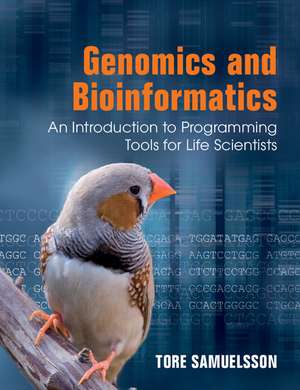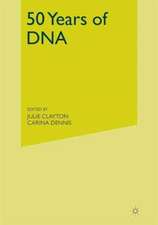Genomics and Bioinformatics: An Introduction to Programming Tools for Life Scientists
Autor Tore Samuelssonen Limba Engleză Paperback – 6 iun 2012
| Toate formatele și edițiile | Preț | Express |
|---|---|---|
| Paperback (1) | 440.36 lei 6-8 săpt. | |
| Cambridge University Press – 6 iun 2012 | 440.36 lei 6-8 săpt. | |
| Hardback (1) | 912.26 lei 6-8 săpt. | |
| Cambridge University Press – 6 iun 2012 | 912.26 lei 6-8 săpt. |
Preț: 440.36 lei
Preț vechi: 494.78 lei
-11% Nou
Puncte Express: 661
Preț estimativ în valută:
84.27€ • 91.51$ • 70.79£
84.27€ • 91.51$ • 70.79£
Carte tipărită la comandă
Livrare economică 22 aprilie-06 mai
Preluare comenzi: 021 569.72.76
Specificații
ISBN-13: 9781107401242
ISBN-10: 1107401240
Pagini: 358
Ilustrații: 20 b/w illus. 70 colour illus. 23 tables 60 exercises
Dimensiuni: 189 x 245 x 17 mm
Greutate: 0.75 kg
Editura: Cambridge University Press
Colecția Cambridge University Press
Locul publicării:New York, United States
ISBN-10: 1107401240
Pagini: 358
Ilustrații: 20 b/w illus. 70 colour illus. 23 tables 60 exercises
Dimensiuni: 189 x 245 x 17 mm
Greutate: 0.75 kg
Editura: Cambridge University Press
Colecția Cambridge University Press
Locul publicării:New York, United States
Cuprins
Preface; Acknowledgements; Design and conventions of this book; 1. Introduction - working with the molecules of life in the computer; 2. Gene technology - cutting DNA; 3. Gene technology - knocking genes down; 4. Gene technology - amplifying DNA; 5. Human disease - when DNA sequences are toxic; 6. Human disease - iron imbalance and the iron responsive element; 7. Human disease - cancer as a result of aberrant proteins; 8. Evolution - what makes us human?; 9. Evolution - resolving a criminal case; 10. Evolution - the sad case of the Tasmanian tiger; 11. A function to every gene - termites, metagenomics and learning about the function of a sequence; 12. A function to every gene - royal blood and order in the sequence universe; 13. A function to every gene - a slimy molecule; 14. Information resources - learning about flu viruses; 15. Finding genes - going ashore at CpG islands; 16. Finding genes - in the world of snurps; 17. Finding genes - hunting for the distant RNA relatives; 18. Personal genomes - the differences between you and me; 19. Personal genomes - what's in my genome?; 20. Personal genomes - details of family genetics; Appendix I. Brief Unix reference; Appendix II. A selection of biological sequence analysis software; Appendix III. Short Perl reference; Appendix IV. Brief introduction to R; Index.
Recenzii
'The book provides a lively and accessible introduction to current research in the life sciences, and it does so in a succinct way by grounding the explanations with simple algorithms expressed in Perl code. As such, the book can be very useful to a general science audience, particularly those with a computer science background, whether established researchers or undergraduate students. The writing is inspiring and engaging, and the inclusion of Perl code makes it easy for readers to apply the knowledge and observe the outcomes.' Sara Kalvala, Computing Reviews
Notă biografică
Descriere
A hands-on introduction to Unix, Perl and other bioinformatics tools using relevant and interesting molecular biology problems.






